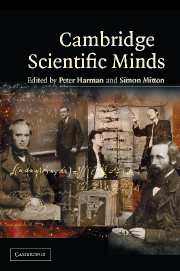Book contents
- Frontmatter
- Contents
- Foreword
- Introduction
- 1 William Gilbert
- 2 William Harvey
- 3 Isaac Newton: Creator of the Cambridge scientific tradition
- 4 William Whewell: A Cambridge historian and philosopher of science
- 5 Adam Sedgwick: A confident mind in turmoil
- 6 Charles Babbage: Science and reform
- 7 Charles Darwin
- 8 Stokes and Kelvin, Cambridge and Glasgow, light and heat
- 9 James Clerk Maxwell
- 10 The duo from Trinity: A.N. Whitehead and Bertrand Russell on the foundations of mathematics, 1895–1925
- 11 Thomson, Rutherford and atomic physics at the Cavendish
- 12 Hopkins and biochemistry
- 13 Charles Sherrington, E.D. Adrian, and Henry Dale: The Cambridge Physiological Laboratory and the physiology of the nervous system
- 14 Hardy and Littlewood
- 15 Arthur Stanley Eddington
- 16 Paul Dirac: A quantum genius
- 17 Alan Turing
- 18 Francis Crick and James Watson
- 19 Mary Cartwright
- 20 Joseph Needham
- 21 Molecular biology in Cambridge
- 22 The discovery of pulsars – prelude and aftermath
- 23 Stephen W. Hawking
9 - James Clerk Maxwell
Published online by Cambridge University Press: 05 June 2014
- Frontmatter
- Contents
- Foreword
- Introduction
- 1 William Gilbert
- 2 William Harvey
- 3 Isaac Newton: Creator of the Cambridge scientific tradition
- 4 William Whewell: A Cambridge historian and philosopher of science
- 5 Adam Sedgwick: A confident mind in turmoil
- 6 Charles Babbage: Science and reform
- 7 Charles Darwin
- 8 Stokes and Kelvin, Cambridge and Glasgow, light and heat
- 9 James Clerk Maxwell
- 10 The duo from Trinity: A.N. Whitehead and Bertrand Russell on the foundations of mathematics, 1895–1925
- 11 Thomson, Rutherford and atomic physics at the Cavendish
- 12 Hopkins and biochemistry
- 13 Charles Sherrington, E.D. Adrian, and Henry Dale: The Cambridge Physiological Laboratory and the physiology of the nervous system
- 14 Hardy and Littlewood
- 15 Arthur Stanley Eddington
- 16 Paul Dirac: A quantum genius
- 17 Alan Turing
- 18 Francis Crick and James Watson
- 19 Mary Cartwright
- 20 Joseph Needham
- 21 Molecular biology in Cambridge
- 22 The discovery of pulsars – prelude and aftermath
- 23 Stephen W. Hawking
Summary
In Cambridge University's Cavendish Laboratory, alongside intricately impressive devices such as cloud chambers and mass spectroscopes, there is preserved an intriguing ‘wheel of life’. A regularly slotted cylinder has a sequence of pictures carefully drawn on a removable strip of paper on its inner surface. As it spins vertically, persistence of vision gives a spectator peering through the slots the impression the figures are moving. This wheel is not on show merely because it was an important step towards stroboscopes and cinematography. It is there because this version was built in 1868 by a Glasgow instrument maker for James Clerk Maxwell (1831–1879), first head of the Cavendish Laboratory and supreme Victorian physicist. Maxwell put concave lenses of focal length equal to the wheel's diameter into the slits so every visible figure would be stationary. ‘The unlearned pronounce it lively.’ He designed fascinating images: boys play leapfrog, pine trees grow, acrobats leap, and fountains change colour. But he also showed cylinders in a resisting fluid, vibrating wires, and the behaviour of those interwoven vortex rings reckoned the basic constituents of matter by many nineteenth-century natural philosophers. He discussed his wheel of life with one natural philosopher, the Glasgow professor, William Thomson, then set its theory as a puzzle for the Cambridge Mathematics Tripos in January 1869. Maxwell had first played with zoetropes, to use their grander name, as a boy on his father's Glenlair estate in southwest Scotland in the 1830s.
- Type
- Chapter
- Information
- Cambridge Scientific Minds , pp. 123 - 140Publisher: Cambridge University PressPrint publication year: 2002
- 3
- Cited by



